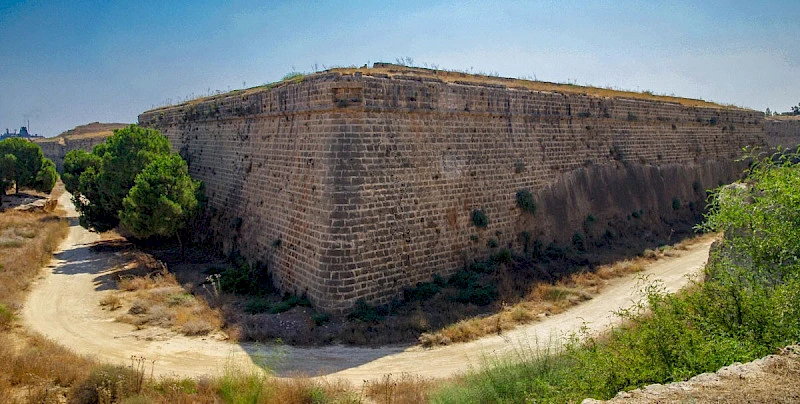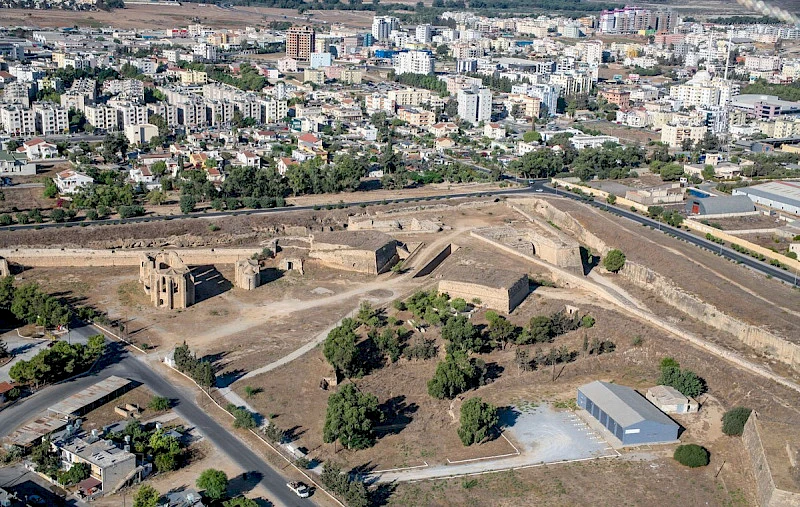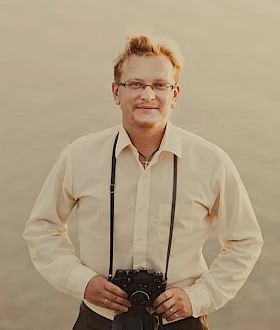Martinengo Bastion
Martinengo Bastion is a relatively recently restored historical site located in the very center of Famagusta.
As part of the Venetian city walls, Martinengo Bastion, also known as Tophane, offers a glimpse into the island's military past. Its strategic location provides visitors with a unique view of the old town and Famagusta's port.
- History of the Bastion
- Defensive Features
- Restoration of the Bastion
- What Else to See
- Frequently Asked Questions

History of Martinengo Bastion
Martinengo Bastion was built in the 16th century by the Venetians as part of their fortification efforts to protect Famagusta from Ottoman invasions. When the Venetians arrived in Cyprus, they quickly realized that none of the city's walls were suitable for modern defense and began significant changes to the city's appearance.
The weakest part of the city walls was in the northwest corner. In 1550, the renowned Venetian architect Giovanni San Michele arrived on the island to redesign and reinforce this section. He died in Famagusta in 1559 while the fortifications were still under construction and was buried in the Cathedral of St. Nicholas in the city center. The defensive works were continued by Luigi Brugnoli until their completion in 1562.
The bastion was named after the Venetian commander Iernino Martinengo, who rushed to help during the Ottoman siege of Famagusta. Commander Martinengo died en route, his body was brought to Famagusta, and the bastion was named in his honor.
During the Ottoman siege of Famagusta in 1570-71, the bastion played a crucial role in the city's defense, though it ultimately fell to the Ottoman forces. Today, the bastion stands as a symbol of the city's rich military heritage.
Defensive Features of the Bastion
Martinengo is one of the finest examples of medieval military architecture, built in the shape of an arrowhead pointing into the city. Its design not only provided a wide field of fire away from the walls but also ensured that if attackers breached the moat and attacked the weaker defensive walls, the line of fire could be directed along the walls.
The walls were up to six meters thick. Earth was used as the primary construction material to absorb the impact of any fire. The bastion was surrounded by wide moats and covered a vast area, allowing it to accommodate the largest Venetian cannons and fire in multiple directions.
The lower parts of the fortress, where possible, were embedded into the rock, preventing tunneling or the placement of explosives beneath them. Access to the interior was provided via double ramps, allowing horses and heavy ammunition to be quickly and easily transported to supply the bastion's cannons.
Restoration of Martinengo Bastion
Over the years, Martinengo Bastion has undergone several restoration efforts aimed at preserving its structural integrity and historical significance.
Recently, the bastion was carefully restored with funding from the United Nations Development Programme. The restoration work included reinforcing the walls, repairing damage caused by time, and improving the surrounding area to enhance accessibility.
- You can find the full list of restoration works in the UNDP brochure.
What Else to See Besides the Bastion
There are two interesting churches within the bastion's grounds.
Protected by the bastion walls, the Armenian monastery of Ganchvor was built in 1364 by Armenian refugees from the historical region of Cilicia (now part of Turkey). The church's architecture is distinctly different from other buildings in Famagusta.
The Church of Our Lady of Mount Carmel is located next to the Ganchvor Monastery and was built in the same century. However, it has been significantly less preserved. Nevertheless, it is still worth a visit to compare the architecture of both churches.
Around Martinengo Bastion, visitors can explore other significant historical landmarks, including the city walls of Famagusta, the Cathedral of St. Nicholas, and the Venetian Palace. The site offers stunning views of the Mediterranean Sea and a chance to experience the unique blend of Venetian, Ottoman, and modern influences on the city.

Frequently Asked Questions About Martinengo Bastion
Where is Martinengo Bastion located?
Martinengo Bastion is located in the northwest corner of the walled city. As mentioned, it is part of the city wall itself. A map with its location is available below.
How to reach the bastion by public transport?
The bastion is located in the center of Famagusta, in the old town, and buses do not stop directly at it. The nearest public transport stop is at the roundabout near Anit Park, located here.
Where can I park near Martinengo Bastion?
Parking directly at the bastion is not possible. It is best to park near Othello Castle at these coordinates: 35.127844935153334, 33.941638348614774 (this link opens the parking location on Google Maps). The parking lot is popular since parking in the old town is limited.
- If you do not have a car, you can rent one online via the search aggregator Discover Cars or directly from one of the car rental companies in Northern Cyprus. We covered all the options and procedures in the article «Car Rental in Northern Cyprus».
Follow our Instagram and Telegram channel for the latest insights on Northern Cyprus attractions!

